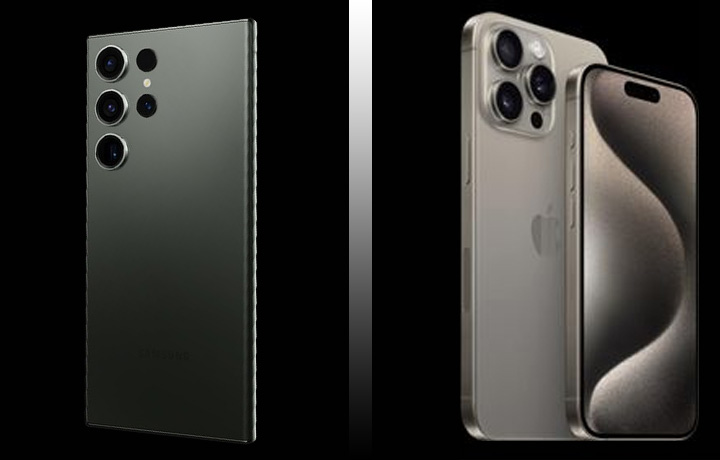iPhone 15 Pro Max vs. Galaxy S23 Ultra: Battle of Titans
In the world of smartphones, two giants stand tall, consistently pushing the boundaries of innovation and technology. In 2023, Apple and Samsung have once again released their flagship devices, the iPhone 15 Pro Max and the Samsung Galaxy S23 Ultra, respectively.
This comparison aims to dissect and analyze these two smartphones, examining their value, design, features, performance, camera capabilities, battery life, and software. Ultimately, we’ll determine if Apple has successfully challenged Samsung on its home turf.
- Read also:
- Apple Unveils iPhone 15 and iPhone 15 Pro: Are There Other Reasons To Upgrade Besides USB-C?
- Garmin Venu 3 vs Samsung Galaxy Watch 6: Which One To Buy?
- Apple Watch Ultra vs. Garmin Epix Pro: Buying Guide Comparison
Value Proposition:
In terms of pricing, both the iPhone 15 Pro Max and the Galaxy S23 Ultra demand a substantial investment, with a hefty $1200 price tag. However, Samsung offers a slight edge in the value department.
In select markets, they provide a free storage upgrade, allowing customers to acquire the 512GB model for the same price as the iPhone’s lower storage variants. Moreover, Samsung offers better trade-in values and discounts on other Samsung products, giving them an advantage in the value segment.
Design and Build:
Design-wise, both Apple and Samsung have established their unique design identities over the years. Personal preference largely dictates which design is more appealing, as both companies have mastered the art of crafting premium-looking smartphones.
However, Apple introduces a game-changer with the use of titanium material in the iPhone 15 Pro Max, making it a remarkable 11 grams lighter than the Galaxy S23 Ultra. This seemingly minor weight difference can have a significant impact on real-world usability, highlighting the advantage of Apple’s design choices.
USB-C Port and Features:
Apple’s inclusion of a USB-C port in the iPhone 15 Pro Max represents a significant shift, but Samsung emerges as the clear winner in this aspect. Both phones feature third-generation USB-C ports with 10 gigabit speed transfer capabilities. However, Samsung takes the lead with its 45W fast charging support, charging the S23 Ultra in approximately 57 minutes, compared to the iPhone’s 1 hour and 44 minutes. Samsung unequivocally wins the USB-C war.
Apple’s innovative addition to the iPhone 15 Pro Max is the action button—a pressure-sensitive button that can perform various functions. While Apple’s implementation offers deep functionality, Samsung already had an action button in the form of its power key, allowing users to assign different actions to double presses or long presses. Both phones offer valuable customization options, making it a matter of personal preference.
- Read also:
- Tecno Spark 10 Pro vs. Samsung Galaxy A34
- iPhone 14 Pro Max Review
- Asus Zenfone 10 vs. Samsung Galaxy S23
Display:
In terms of display, both phones offer stunning visuals with slim bezels and exceptional brightness levels. The iPhone boasts 2000 nits of brightness, slightly surpassing the 1800 nits on the Galaxy S23 Ultra.
However, the real differentiator is the dynamic island build, a software feature that provides ongoing notifications on the iPhone. While it’s a cool trick, Samsung maintains a cleaner look with its single punch hole in the middle, making it preferable for some users, particularly when consuming content like Netflix.
Performance and Gaming:
Performance is an area where Apple has historically excelled, and the iPhone 15 Pro Max continues this trend. Powered by the three-nanometer Apple A17 Pro chip, it outperforms the Galaxy S23 Ultra‘s four-nanometer Exynos 2 chip in both CPU scores and power efficiency.
The standout feature, however, is the new GPU on the A17 Pro, capable of running console games like Resident Evil 4 and Resident Evil Village. This is a game-changer for mobile gaming, and Apple deserves credit for pushing the envelope. Samsung, despite its talk of ray tracing, has yet to collaborate with game studios to bring console games to its phones.
Cameras:
The camera department is where Apple faces a formidable challenge from Samsung. Apple has replaced the 3x zoom on the iPhone 15 Pro Max with a 5x Periscope Zoom sensor. While this is a step forward, it’s not enough to compete with Samsung’s massive 10x optical zoom, extendable to 100x. Samsung also offers a separate 3x optical zoom for portraits, a feature the iPhone lacks. Digital portraits may not match the quality of Samsung’s optical zoom, potentially putting Apple at a disadvantage.
On the main camera front, Apple introduces a significant change, allowing the phone to capture 24-megapixel shots by default. This gives users more flexibility in terms of high-resolution photography. Samsung, on the other hand, maintains a 12-megapixel sensor, emphasizing image processing over raw megapixels. The real battle here will come down to which manufacturer can provide superior image processing, as higher resolution doesn’t necessarily guarantee better results.
Video capabilities remain largely unchanged, with Apple focusing on consistency and reliability in video performance. While the S23 Ultra offers 8K video recording, Apple’s 4K videos tend to be more reliable in terms of colors and exposure management. If consistency is a priority, Apple has the upper hand.
Battery Performance:
One might expect the iPhone 15 Pro Max to dominate in battery performance, thanks to its three-nanometer chip. However, Apple hasn’t announced any notable improvements in this regard, likely maintaining similar battery life to its predecessor.
In contrast, the Galaxy S23 Ultra offers comparable battery performance to the iPhone 14 Pro Max but combines it with 45W fast charging, ensuring longer-lasting usage and quicker recharges. Samsung takes the lead in battery performance.
Software and Ecosystem:
Both iOS 17 and One UI 6.0 are mature operating systems that cater to a wide range of users. The choice between Android and iOS ultimately depends on your current ecosystem and personal preferences. However, some key distinctions exist.
Samsung offers a unique Dex mode that transforms the S23 Ultra into a laptop-like experience, a feature the iPhone cannot replicate despite its A17 Pro chip. Additionally, the S23 Ultra is the only phone on the market to include a built-in stylus, enhancing its versatility.
Apple boasts strong features like iMessage and FaceTime, along with exclusive console games. These exclusives set the iPhone apart in the gaming department. However, it’s worth noting that Samsung’s ecosystem is also rich, with a wide range of compatible devices and services.
- Shopping Links:
- Buy Samsung Galaxy S23 Ultra>>
- Buy Samsung Galaxy Watch 6>>
- Buy Garmin Venu 3 here>>
- Buy Garmin Epix Pro here>>
Conclusion:
In the battle between the iPhone 15 Pro Max and the Samsung Galaxy S23 Ultra in 2023, it’s clear that both companies have brought their A-game. While Apple introduces notable innovations like the use of titanium, a USB-C port, and console gaming capabilities, Samsung holds its ground with superior zoom capabilities, faster charging, and unique features like Dex mode and a built-in stylus.
Ultimately, the choice between these two titans comes down to individual preferences and priorities. If you value camera versatility and zoom capabilities, the S23 Ultra shines. If gaming and Apple’s ecosystem are more appealing, the iPhone 15 Pro Max may be the better choice.
One thing is certain: the competition between Apple and Samsung in 2023 continues to drive innovation in the smartphone industry, benefitting consumers with an array of cutting-edge features and capabilities.
- Shop On Amazon Using Our Links To Support Us:
- Buy Garmin Forerunner 265 – Buy Samsung Galaxy S23 Ultra
- Amazon best sellers – Amazon most gifted – Amazon under $25






